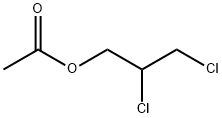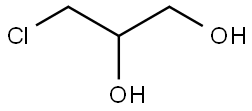
2-chloropropane-1,3-diol synthesis
- Product Name:2-chloropropane-1,3-diol
- CAS Number:497-04-1
- Molecular formula:C3H7ClO2
- Molecular Weight:110.54

64-19-7
1530 suppliers
$10.00/25ML

56-81-5
1625 suppliers
$5.00/25g

616-23-9
135 suppliers
$39.50/5g

497-04-1
62 suppliers
$60.00/25 mg

96-23-1
281 suppliers
$10.00/1g

589-96-8
2 suppliers
inquiry

3674-10-0
2 suppliers
inquiry
Yield:96-23-1 53.74% ,616-23-9 1% ,497-04-1 1.88% ,3674-10-0 4.75% ,589-96-8 0.43%
Reaction Conditions:
with hydrogenchloride at 90 - 123; under 5414.51 - 5724.8 Torr; for 1.5 - 2 h;Product distribution / selectivity;
Steps:
42
After nitrogen purging (two 40 psig pressure/vent cycles), dry glycerin (30.0 g, 0.320 mole) containing 4 wt% acetic acid (1.2 g Aldrich) as a catalyst was subjected to static pressures 90-96 psig of anhydrous HC1 with stirring and heating in a magnetically driven, 100 mL Hasteloy-C Parr reactor. This reactor was equipped with an internal thermocouple which measured the internal solution temperature. External heating to the reactor was provided by an immersion bath which was controlled with a temperature controller. At initial internal temperatures of 90 °C, an almost immediate exotherrn ensued and within 10 minutes the internal reaction temperature was 120-123 °C. The exotherrn was accompanied by rapid uptake of HC1. The immersion bath was raised to this temperature for 1.5-2 hours and HC1 was monitored via a weigh cell (the cylinder) and a computer control system. After this period of time, virtually no more HC1 uptake was apparent (approximately 32.1 g uptake). The reactor was cooled to room temperature, carefully vented to an HC1 purge column, opened and the contents (68.0 g) were transferred to a glass bottle with a polyethylene screw-cap. Accurate H2O, HC1 and wt % organic balance was obtained on this and other samples.The results of analysis and the chemical scheme is shown in Scheme 4 below.Scheme 4oOH „ ... oX.OH CI+ ^k +OH OH 90-96 nsln HC1 Li.. i. I90-96 psigHCI C| QH L, £, C. CI OH CIMomKIoq C2H4°2 9°-120°C CgHyClOa C5H8CI202 C3H6CI20Mol. Wt.. 92.09 Mol. Wt.: 60.05 Mol.Wt: 110.54 Mol. Wt.: 171.02 Mol. Wt: 128.9830.0 g 1.2 g0.326 mol 4.0 wt % rS+ MCH-monoacetate + Cl-ethersobtained 68.0 g final solutionOH OHC3H7CI02 Mol.Wt.: 110.54A comparison of the results of Example 42 and Comparative Example B is shown in Table II below.Table IIComponentExample 42Pressure HCl32.1 gHCl(Wt%)Comparative Example BAtmospheric HCL700 gHCl(Wt%)Acetic acid3.60.441,3-DCH53.7457.782,3-DCH11.113-chloro-l,2-propanediolND*9.982-chloro-l,3-propanediol1.884.03glycerolNDND2-acetoxy-2,3-dichloropropane4.750.34l-acetoxy-2,3-dichloropropane0.43ND1 -acetoxy3-chloro-2-propanolND0.42acetoxychloropropanol1.250.23diacetoxychloropropane0.3NDChloroether dimers (RCl's)0.080.3water16.817.65HCl14.977.7Total mass balance99.399.98*ND = not detectedComparative Example B shows that prolonged reaction time and loss of catalysts is experienced in the atmospheric pressure example versus the superatmospheric pressure process. Also, unexpectedly, a greater conversion of monochlorohydrin to dichlorohydrin is experienced in the superatmospheric case and less chloroether (RC1) is produced. A major loss of HCl is experienced in Comparative Example B.
References:
DOW GLOBAL TECHNOLOGIES INC. WO2006/20234, 2006, A1 Location in patent:Page/Page column 35-37

56-81-5
1625 suppliers
$5.00/25g

616-23-9
135 suppliers
$39.50/5g

497-04-1
62 suppliers
$60.00/25 mg

96-23-1
281 suppliers
$10.00/1g

96-24-2
291 suppliers
$11.00/5g

56-81-5
1625 suppliers
$5.00/25g

497-04-1
62 suppliers
$60.00/25 mg

96-23-1
281 suppliers
$10.00/1g

96-24-2
291 suppliers
$11.00/5g

56-81-5
1625 suppliers
$5.00/25g

616-23-9
135 suppliers
$39.50/5g

497-04-1
62 suppliers
$60.00/25 mg

96-23-1
281 suppliers
$10.00/1g